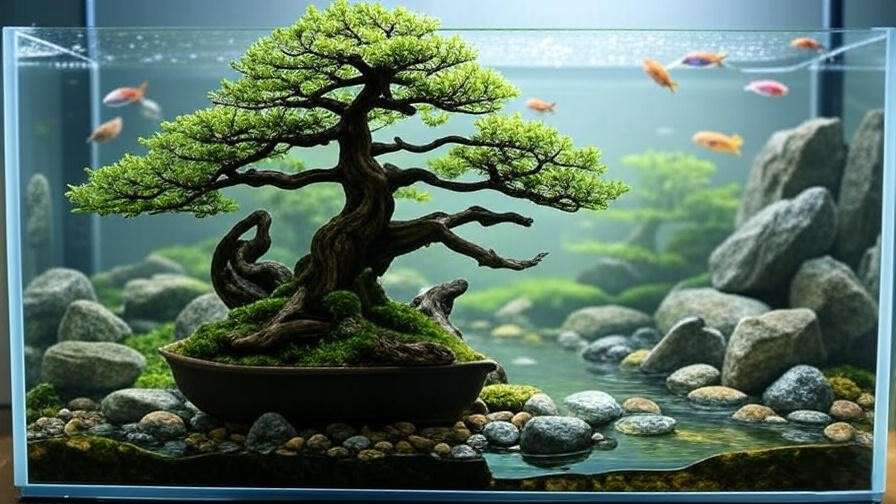Picture this: a tiny, sculpted tree swaying gently in your aquarium, its delicate branches draped in lush green moss, creating a serene underwater forest that captivates both you and your fish. The aquarium bonsai tree is more than just a decoration—it’s a living work of art that blends the timeless elegance of bonsai with the tranquil beauty of an aquatic ecosystem. Whether you’re a seasoned aquarist or a beginner looking to elevate your tank, this guide will walk you through every step of creating and maintaining a stunning aquarium bonsai tree. With expert insights and practical tips, you’ll learn how to craft a thriving underwater masterpiece that enhances your tank’s aesthetic and supports a healthy environment for your fish. Let’s dive in! 🌊
What Is an Aquarium Bonsai Tree? 🌿
An aquarium bonsai tree is a miniature tree-like structure designed to mimic the aesthetic of traditional bonsai within an aquatic environment. Unlike terrestrial bonsai, which require meticulous pruning and soil care, aquarium bonsai trees are crafted using aquarium-safe materials like driftwood, live aquatic plants, or moss to create a natural, tree-like appearance. These creations serve as the centerpiece of an aquascape, transforming a standard fish tank into a breathtaking underwater landscape.
Benefits of Adding a Bonsai Tree to Your Aquarium 🐟
Adding an aquarium bonsai tree to your tank offers multiple advantages:
- Aesthetic Appeal: It creates a visually striking focal point, mimicking natural landscapes like riverbeds or forested streams.
- Fish-Friendly Environment: The tree provides shelter and hiding spots, reducing stress for fish and invertebrates.
- Low Maintenance: Compared to traditional bonsai, aquarium versions require less intensive care, making them ideal for busy hobbyists.
- Ecosystem Support: Moss and plants foster beneficial microorganisms, contributing to a balanced tank ecosystem.
Expert Insight: According to aquascaping expert Takashi Amano, whose work revolutionized modern aquarium design, incorporating natural elements like bonsai-inspired structures enhances both the visual and ecological harmony of an aquarium. 🌍
Choosing the Right Materials for Your Aquarium Bonsai Tree 🛠️
Selecting the right materials is critical to creating a safe and visually appealing aquarium bonsai tree. Your choices will impact both the health of your tank and the longevity of your bonsai creation.
Selecting the Base Structure
The foundation of your aquarium bonsai tree is typically driftwood or live plants, each offering unique benefits.
Driftwood vs. Live Plants
- Driftwood: Materials like Malaysian driftwood or Mopani wood are popular for their durability and natural, gnarled shapes that mimic tree trunks. Ensure the wood is aquarium-safe by soaking it for 1-2 weeks to remove tannins, which can discolor water.
- Live Plants: Species like Anubias nana or Bucephalandra provide a living, growing base that adds vibrancy. These plants are hardy and thrive in low-to-moderate light, making them ideal for beginners.
- Safety Tip: Always sterilize driftwood by boiling or soaking in a mild bleach solution (rinsed thoroughly) to eliminate pathogens.
Choosing Aquatic Moss and Foliage 🌱
Moss is the “foliage” of your aquarium bonsai tree, giving it that lush, leafy appearance. Popular choices include:
- Java Moss: Versatile and easy to grow, it adheres well to driftwood and thrives in various conditions.
- Christmas Moss: Offers a denser, more structured look, perfect for intricate bonsai designs.
- Selection Tips: Choose moss with vibrant green color and no signs of algae. Source from reputable aquarium suppliers or online retailers like Buce Plant or Aquarium Co-Op to ensure quality.
Checklist: Before purchasing, verify that materials are free of pesticides, sharp edges, or contaminants that could harm your tank’s inhabitants. 🧼
Step-by-Step Guide to Creating Your Aquarium Bonsai Tree 🪚
Creating an aquarium bonsai tree is a rewarding process that combines creativity with technical know-how. Follow these steps to craft your own underwater masterpiece.
Designing Your Bonsai Masterpiece
Before you start, plan your design to ensure it complements your tank’s size and aesthetic.
- Sketch the Shape: Aim for asymmetry and natural curves, inspired by traditional bonsai styles like Moyogi (upright informal) or Kengai (cascade).
- Size Matters: For a 10-gallon tank, keep the bonsai under 6 inches tall; for larger tanks (20+ gallons), you can go up to 12 inches.
- Fish Compatibility: Avoid overly dense designs that could trap smaller fish or restrict water flow.
Assembling the Bonsai
- Prepare the Base: If using driftwood, soak it for 1-2 weeks to remove tannins and weigh it down (most driftwood floats initially). For live plants, gently rinse roots to remove debris.
- Attach Moss or Plants: Use aquarium-safe glue (e.g., cyanoacrylate gel) or cotton thread to secure moss or plants to the base. For a natural look, wrap moss loosely to mimic foliage.
- Shape the Tree: Use pruning shears to trim excess moss or plant growth, creating a refined bonsai silhouette. Be gentle to avoid damaging live plants.
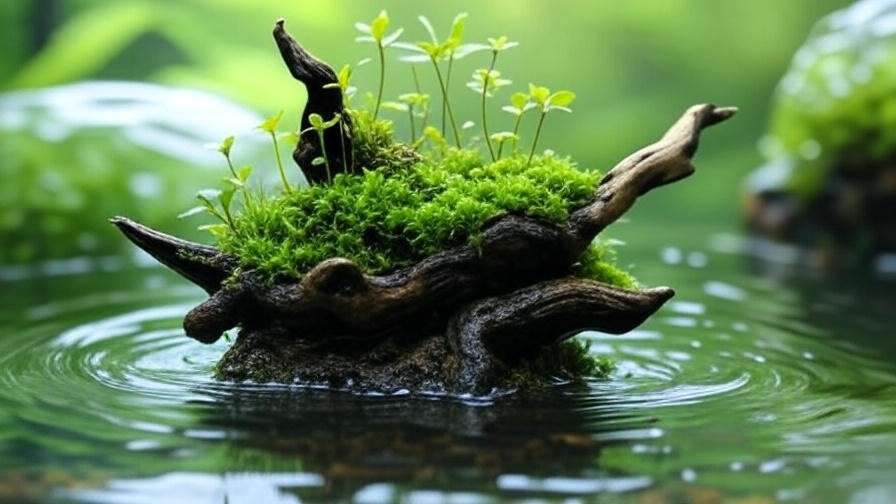
Placing It in Your Aquarium
- Positioning: Follow the aquascaping “rule of thirds” by placing the bonsai off-center for a balanced, natural look.
- Securing: Anchor the bonsai with aquarium-safe rocks or substrate to prevent floating. For live plants, ensure roots are partially buried in substrate for nutrient access.
- Water Flow and Light: Position the bonsai where it receives adequate light (more on this below) and doesn’t obstruct water circulation.
Case Study: In a 20-gallon tank, aquarist Sarah L. created a stunning bonsai using Malaysian driftwood and Java moss, paired with neon tetras. The tree’s compact 8-inch height and open structure allowed fish to swim freely, while the moss thrived under moderate LED lighting. 📸
Caring for Your Aquarium Bonsai Tree 🌊
Once your bonsai is in place, proper care ensures it remains vibrant and healthy. Here’s how to maintain it like a pro.
Lighting Requirements 💡
Lighting is crucial for live plants and moss, which rely on photosynthesis.
- Optimal Levels: Use 6500K LED lights with 1-2 watts per gallon for low-light plants like Anubias or Java moss. Provide 8-10 hours of light daily.
- Algae Prevention: Avoid excessive lighting (over 12 hours) to prevent algae growth on your bonsai. Use a timer for consistency.
- Pro Tip: Adjustable LED lights, like the Fluval Plant 3.0, allow you to fine-tune intensity for optimal plant growth.
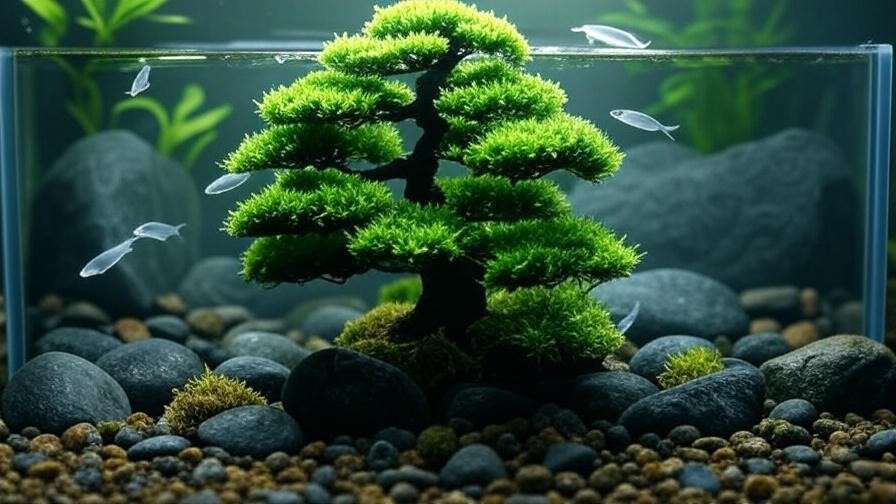
Water Quality and Parameters
Healthy water is the backbone of a thriving aquarium bonsai tree.
- Ideal Parameters: Maintain a pH of 6.5-7.5, water hardness of 3-8 dKH, and temperature of 75-80°F for most bonsai plants.
- Testing: Use a reliable water testing kit weekly to monitor ammonia, nitrites, and nitrates. Perform 10-20% water changes biweekly to keep parameters stable.
- Filtration: Ensure your filter provides gentle water flow to avoid dislodging moss or stressing plants.
Pruning and Trimming ✂️
Regular maintenance keeps your bonsai’s shape intact.
- How to Trim: Use aquascaping scissors to snip overgrown moss or plant leaves, focusing on maintaining the bonsai silhouette.
- Frequency: Perform light touch-ups monthly and major reshaping every 3-6 months, depending on growth rate.
- Caution: Avoid over-pruning live plants, as this can stunt growth or cause dieback.
Nutrient and CO2 Supplementation
Live plants and moss benefit from occasional nutrient boosts.
- Fertilizers: Use liquid fertilizers like Seachem Flourish, dosed weekly per manufacturer instructions, to provide essential micronutrients.
- CO2: For faster growth, consider a low-dose CO2 system (e.g., 1-2 bubbles per second for a 20-gallon tank).
- Warning: Over-fertilization can cause algae blooms, so start with half the recommended dose and monitor plant response.
Expert Quote: “Consistency in water quality and light exposure is key to a thriving aquarium bonsai,” says Dr. Jane Kim, a botanist specializing in aquatic plants. “Treat your tank like a living ecosystem, not just a display.” 🧑🌾
Common Challenges and Solutions 🚨
Even with the best care, you may encounter issues with your aquarium bonsai tree. Here’s how to troubleshoot common problems to keep your underwater masterpiece thriving.
Algae Growth on Bonsai
Algae can detract from the beauty of your bonsai and harm live plants if left unchecked.
- Causes: Excessive light (over 12 hours daily), high nitrate levels, or poor water circulation.
- Solutions:
- Reduce lighting to 8-10 hours and use a timer for consistency.
- Introduce algae-eating species like Siamese algae eaters or nerite snails, which are safe for most plants.
- Use an aquarium-safe algae inhibitor, such as Seachem Purigen, to control nutrient levels.
- Prevention Tip: Maintain a regular water change schedule (10-20% biweekly) to keep nitrates low and discourage algae growth.
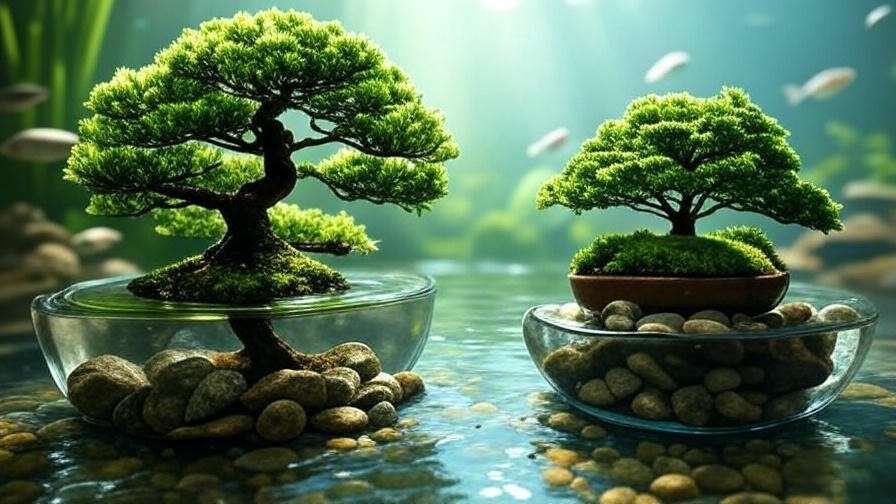
Plant Browning or Dying
If your bonsai’s plants or moss start to brown or wilt, quick action can save them.
- Causes: Insufficient light, poor water quality, or nutrient deficiencies.
- Solutions:
- Check lighting: Ensure your tank provides 1-2 watts per gallon for low-light plants like Anubias or Java moss.
- Test water parameters: Address high ammonia or nitrites with water changes and improved filtration.
- Supplement with a liquid fertilizer like API Leaf Zone to boost nutrient levels.
- Pro Tip: If browning persists, inspect roots for rot and trim affected areas with sterile scissors to prevent spread.
Bonsai Floating or Shifting
A floating or unstable bonsai can disrupt your tank’s aesthetic and stress fish.
- Causes: Buoyant driftwood, inadequate anchoring, or loose substrate.
- Solutions:
- Soak driftwood for an additional 1-2 weeks to ensure it’s waterlogged and sinks naturally.
- Secure the bonsai with aquarium-safe weights, such as slate rocks or stainless steel plant anchors.
- Add a layer of fine gravel or sand around the base to stabilize it in the substrate.
- Checklist: Before placing your bonsai, test its stability by gently nudging it to ensure it won’t tip or float. 📋
Troubleshooting Tip: Keep a journal of your tank’s parameters and maintenance schedule to identify patterns if issues arise. This practice, recommended by the Aquatic Plant Society, helps pinpoint problems early.
Enhancing Your Aquarium Bonsai Experience 🌈
A well-crafted aquarium bonsai tree is just the beginning. Pairing it with the right tank mates and complementary elements can elevate your aquascape to new heights.
Pairing Your Bonsai with Tank Mates
Choosing fish and invertebrates that complement your bonsai ensures a harmonious tank.
- Best Choices:
- Neon Tetras: Their vibrant colors contrast beautifully with green moss, and they’re peaceful enough not to disturb plants.
- Cherry Shrimp: These small invertebrates clean moss and driftwood without damaging them.
- Otocinclus Catfish: Gentle algae-eaters that won’t uproot your bonsai.
- Fish to Avoid:
- Cichlids: Their digging habits can dislodge or damage the bonsai.
- Goldfish: They nibble on plants and produce heavy waste, which can harm water quality.
- Compatibility Tip: Ensure your tank size supports your chosen species (e.g., neon tetras need at least a 10-gallon tank for schooling).
Complementary Aquascaping Elements
Enhance your bonsai’s visual impact by integrating it into a cohesive aquascape.
- Rocks and Substrate: Use smooth river rocks or fine black sand to create a natural base that highlights the bonsai’s structure.
- Background Plants: Add taller plants like Vallisneria or Cryptocoryne to frame the bonsai and create depth.
- Themed Aquascapes: Consider a Zen garden theme with minimalist rocks and white sand or a forest stream look with scattered pebbles and Rotala plants.
- Example: A Zen Bonsai Aquascape could feature a 6-inch bonsai made of Mopani wood and Christmas moss, paired with white quartz substrate, three smooth rocks, and a school of white cloud minnows for a serene, minimalist vibe. 🪨
Expert Insight: Aquascaping champion George Farmer emphasizes that “a successful aquascape balances focal points like a bonsai tree with open space to create a sense of tranquility.” This approach ensures your bonsai remains the star of the tank.
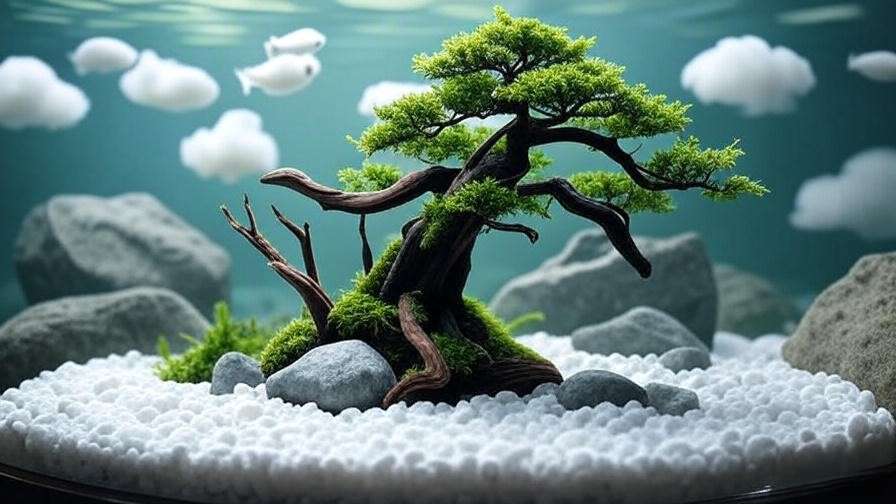
FAQs About Aquarium Bonsai Trees ❓
To address common reader queries and boost SEO with long-tail keywords, here are answers to frequently asked questions about aquarium bonsai trees.
Can Any Plant Be Used for an Aquarium Bonsai Tree?
No, only aquatic or semi-aquatic plants are suitable, as terrestrial plants will rot underwater. Stick to hardy species like Anubias nana, Java fern, or Bucephalandra for best results.
How Long Does It Take for Moss to Grow Into a Bonsai Shape?
Java moss or Christmas moss typically takes 4-8 weeks to fully cover a driftwood structure, depending on light and nutrient levels. Regular trimming helps maintain the desired bonsai shape.
Is an Aquarium Bonsai Tree Safe for All Fish?
Most aquarium bonsai trees are safe, but avoid sharp-edged driftwood or dense designs that could trap small fish. Always choose fish-compatible plants and monitor for any signs of stress.
How Do I Prevent My Bonsai From Rotting?
Use pre-cured driftwood and healthy, aquarium-safe plants. Maintain stable water parameters (pH 6.5-7.5, low ammonia) and ensure good water circulation to prevent decay.
What’s the Best Lighting for an Aquarium Bonsai Tree?
A 6500K LED light providing 1-2 watts per gallon is ideal for low-light plants like Java moss. Use a timer to provide 8-10 hours of light daily to avoid algae issues.
Conclusion: Your Journey to a Thriving Aquarium Bonsai Tree 🌍
Creating and caring for an aquarium bonsai tree is a rewarding journey that blends creativity, science, and nature. From selecting the perfect driftwood and moss to designing a stunning centerpiece and maintaining optimal tank conditions, this guide has equipped you with everything you need to succeed. Your bonsai will not only elevate your aquarium’s aesthetic but also create a thriving, fish-friendly ecosystem that brings joy to both you and your aquatic companions.
Ready to start? Gather your materials, sketch your design, and dive into the art of aquascaping. Share your creations in the comments or on social media—we’d love to see your underwater masterpiece! For further inspiration, explore resources like the International Waterlily and Water Gardening Society or connect with local aquarist communities. Happy aquascaping! 🌱🐠

